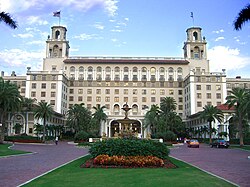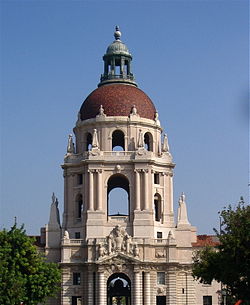
Mediterranean Revival is an architectural style that incorporates traditional design aspects from the Mediterranean region, particularly Italy, Spain, and Greece. [1] The style includes influences from Spanish Renaissance, Spanish Colonial, Italian Renaissance, French Colonial, Beaux-Arts, Moorish, and Venetian Gothic architecture.
Contents
Originating in Italy, the style was introduced to North America in the early 20th century and peaked in popularity during the 1920s and 1930s. [2] It drew heavily on Renaissance-era palaces and seaside villas and applied their elements to the rapidly expanding cities and coastal resorts of Florida and California. The movement also spread to neighboring countries, often through American architects, such as Cuba and Canada.[ citation needed ]
Structures are generally based on a rectangular floor plan, typically one or two stories, which feature massive, symmetrical primary façades. Common characteristics include stuccoed walls, red tiled roofs, arched or circular windows, wood or wrought iron balconies with window grilles, and articulated door surrounds; keystones were occasionally employed, while ornamentation varied from simple to dramatic. [3] [4] The style often integrated lush gardens and landscapes through courtyards, patios, open-air doorways. [1]
Mediterranean Revival was most commonly utilized for hotels, apartment buildings, commercial structures, and residences. Architects August Geiger and Addison Mizner were foremost in Florida, while Bertram Goodhue, Sumner Spaulding, and Paul Williams were in California.[ citation needed ]

